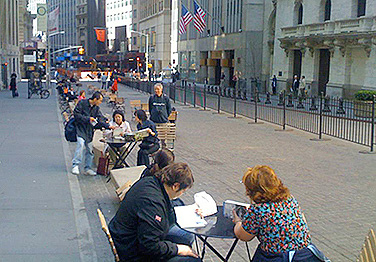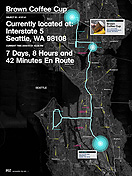News
Exhibit offers whiff of the future

“Breakout,” a winning competitor in the “Toward a Sentient City” competition and exhibition curated by Mark Shepard, takes the “office” to non-traditional sites.
-
 Print
Print -
 Comments
(1)
Comments
(1)
-

“Trash Track” electronically tracks and maps the travels of individual bits of urban trash.
“Toward the Sentient City” is an exhibition two years in the making that originated among UB architects and will give you a whiff of the future, with its smart dust, text messages to fish and devices that provide electricity, then sort of “eat” the carbon dioxide it produces.
The exhibition, which opened in The Urban Center, 457 Madison Ave., in New York City on Sept. 17, was organized by the Architectural League of New York and curated by Mark W. Shepard, UB assistant professor of architecture and media study. It runs through Nov. 7.
Its aim is to give the public a chance to explore the evolving relationship between “ubiquitous computing,” architecture and urban space—a relationship that, whether they know it or not, will deeply affect, even define, their lives in years to come.
“The show consists of five newly commissioned projects distributed throughout New York City and an open archive of related work,” Shepard says. Click here to see the projects.
Shepard says the exhibition builds on a discussion that originated in the 2006 symposium “Architecture and Situated Technologies,” which he organized with UB colleagues Omar Khan, assistant professor of architecture, and Trebor Scholz, assistant professor of media study.
That symposium was developed for the Architectural League in co-production with the UB Center for Virtual Architecture and the Institute for Distributed Creativity, an international network that combines advanced creative production, research, events and documentation.
“The symposium discussion has been extended through the Situated Technologies Pamphlet Series that we continue to edit,” Shepard says.
“This exhibition attempts to manifest some of the more abstract concepts that have evolved out of the conversations between researchers, writers and practitioners of architecture, art, philosophy of technology, comparative media study, performance studies and engineering that have been published in the pamphlet series,” he says.
Shepard says the five commissioned projects were selected from a pool of more than 150 responses to an international request for qualifications issued by the Architectural League in spring 2008. Winners were awarded grants of $15,000 to $25,000 from the J. Clawson Mills Fund of the Architectural League to produce their projects.
In addition to the Mills Fund, support was provided by the Graham Foundation for Advanced Studies in the Fine Arts, as well as the Department of Architecture, UB School of Architecture and Planning, and the Department of Media Study, UB College of Arts and Sciences.
The commissions illustrate some of the unique, exciting and witty ways in which ubiquitous computing can be manifested in an architectural and urban setting:
• “Too Smart City” is a set of three street furniture pieces that come to life with embedded intelligence and robotic systems. The Smart Bench, for instance, is described by its creators as “a gorgeous two-seater that recognizes vagrancy and is capable of lifting people up and dumping them.”
• “Amphibious Architecture” presents two networks of floating interactive tubes, installed in sites in the East River and the Bronx River, that house a range of sensors below water and an array of lights above water. The sensors monitor water quality, the presence of fish and human interest in the river ecosystem. The lights respond to the sensors and create feedback loops between humans and fish, and their shared environment. An SMS interface allows citizens to text-message the fish, to receive real-time information about the river and to contribute to a display of collective interest in the environment.
• “Natural Fuse” harnesses the carbon-sinking capabilities of plants to create a citywide network of devices that act as both electric outlets and resources that offset CO2 generated in the production of electricity.
• “Trash Track” focuses on how pervasive technologies can expose the challenges of waste management and sustainability. The project uses hundreds of small, smart, location-aware tags, a first step toward the deployment of smart-dust—networks of tiny, locatable and addressable micro-electromechanical systems. These tags are attached to different types of trash so that these items can be followed through the city’s waste-management system, revealing the final journey of our everyday objects in a series of real-time visualizations.
• “Breakout!” uses three sets of special tools to explore the dynamic possibilities of a single question: What if the entire city was your office? Drawing inspiration from the shared office spaces of the co-working movement, “Breakout!” creates alternative venues for collaborative work outside traditional office buildings by injecting lightweight versions of essential office infrastructure into urban public spaces.

Reader Comments
Patti Brocato says:
What a great idea, "Breakout" is. I would love to work outside on a sunny, warm day, of course!
Posted by Patti Brocato, Receptionist, UB Child Care Center, 10/01/09